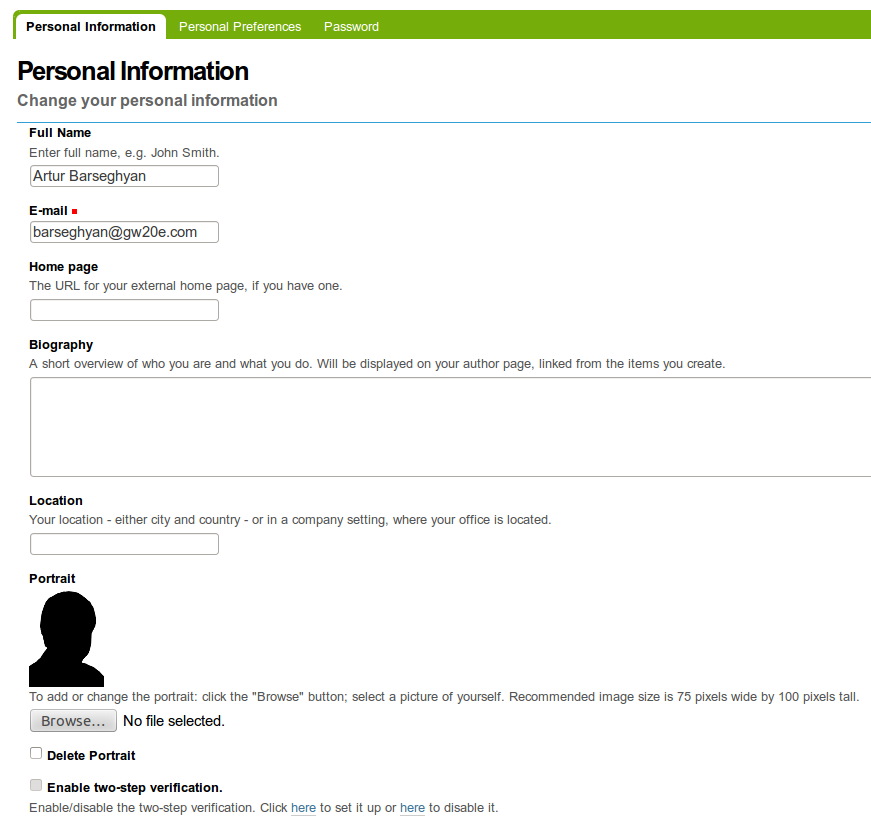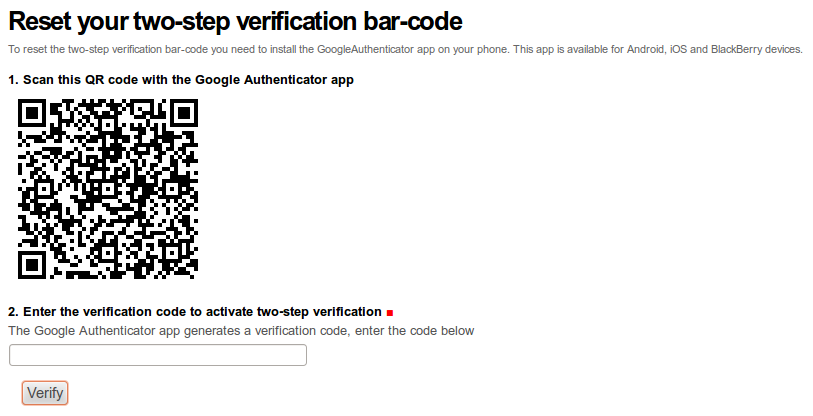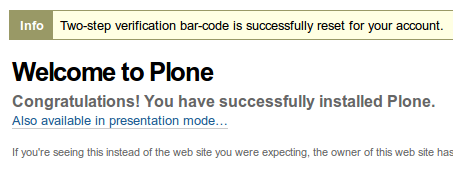collective.googleauthenticator¶
Two-step verification (http://en.wikipedia.org/wiki/Two-step_verification) for Plone 4 with use of Google Authenticator app. This app allows users to enable the two-step verification for their Plone accounts. A mobile device with Google Authenticator app installed is required.
Prerequiresites¶
- GoogleAuthenticator app installed on mobile device (official app available for Android, iPhone and Blackberry; third-party app exists for Windows Phone http://www.windowsphone.com/en-us/store/app/authenticator/e7994dbc-2336-4950-91ba-ca22d653759b)
- Plone 4 (tested with Plone >= 4.2.6)
Usage¶
Case 1: Enabling the two-step verification¶
Pre-conditions: User is not logged into the Plone site, does not yet have two-step verification enabled and has installed the Google Authenticator app (including the advised bar code scanner) on his mobile device.
From “Personal information” page click the first of the two links under “Enable two-step verification”.

That will bring you to a page on which a bar code is shown.

You’re supposed to scan the bar code shown on the page using the bar code scanner installed on your mobile device, which you’re going to use for verification.
After you have successfully scanned the bar code, enter the token shown in the “Enter the verification code to activate two-step verification” field for confirmation and press the “Verify” button.
Upon successful confirmation (you should see a message stating that) the two-step verification is enabled for your account.

Case 2: Two-step verification¶
Pre-conditions: User is not logged in and has enabled the two-step verification.
When you log into the Plone site (just using username and password), you would see an extra screen on which you are asked to provide the token, generated by Google Authenticator.

You should then open the Google Authenticator app on your mobile device and type in the token shown into the “Enter code” field.
If token is valid, you would be logged in.
Case 3: Lost tokens¶
Pre-conditions: User is not logged in, has enabled the two-step verification.
There might be cases when you have lost your token (either removed it from your app by accident or lost the mobile device). For such cases, you can reset the bar code.
Log into the Plone site (just using username and password), for to see the extra screen on which you are asked to provide the token, generated by Google Authenticator and follow the link (help text of the “Enter code” field). You would then land on the page where from you can request the bar code reset.

Enter your username in the “Username” field, press the “Submit” button. Link for resetting your bar code appear in your mailbox shortly. Having clicked on the link to reset the bar code, would bring your to a page where you can scan the bar-code same way you have done it when setting up the two-step verification.

Scan the code with your mobile device and enter the code in the “Enter the verification code to activate the two-step verification” field.
Upon successful confirmation (you should see a message stating that) your bar code is reset.

Case 4: Disabling the two-step verification¶
Pre-conditions: User is logged in and has enabled the two-step verification.
From “Personal information” page click the second of the two links under “Enable two-step verification”.

Implementation details¶
This package is beta. Comments and suggestions are welcome.
Plone PAS plugin, which checks if user has the two-step verification enabled for user trying to log in. If so, redirect user to a separate page (a view), where the extra credentials (Google Authenticator token) is asked for.
Google Authenticator token validation form view. If token is valid, definitely authenticates the user.
Google Authenticator setup form view, where each user scans a bar code image is shown and fills in the token generated by his Google Authenticator app. Upon successful token validation, the two-step verification is enabled for the user.
- User record is extended with two fields:
- enable_two_factor_authentication (bool): Indicates whether user has enabled the two-step verification for his profile.
- two_factor_authentication_secret (str): Users’ secret key to be used for generating the bar code image. Filled in automatically when user enables the two-step verification.
Google Authenticator disable view, on which user can disable the two-step verification for his account.
The Plone standard login form (skins/login_form.cpt) has been overridden (the came_from form field taken out). Still the “came from” functionality works still in the very same way as it was before, just slightly different - in a way that it works well with Google Authenticator too.
The Plone standard “popupforms.js” has been overridden. The part of login forms being shown in an overlay has been taken out, due to the problems of Google Authenticator working with overlays. This issue might be solved in future versions of the app.
Installation¶
Buildout¶
>>> [instance]
>>> eggs +=
>>> collective.googleauthenticator
>>> zcml +=
>>> collective.googleauthenticator
ZMI¶
ZMI -> portal_quickinstaller¶
Choose “Google Authenticator Plone” and install it.
ZMI -> acl_users¶
Choose “Collective Google Authenticator PAS” from the drop down menu (upper right corner of the page).
Make sure the “Active plugins” section of “Authentication” has the following plugins in the given order (critical!):
- collective_google_authenticator
- session
- source_users
App specific settings¶
Go to the app settings (http://your-plone-site.com/@@google-authenticator-settings) and enter a secret key (can be any string; think of it as some sort of a password).
Notes¶
It’s important that Google Authenticator comes as first in the ZMI -> acl_users -> Authentication.
Tested in combination with the following products:
- The Products.LoginLockout (https://pypi.python.org/pypi/Products.LoginLockout). GoogleAuthenticator comes as first, LoginLockout as second. All works fine.
Documentation¶
See the documentation at:
Development status¶
Beta
Support¶
For feature requests or bugs, open an issue. For questions, send us an email to info@gw20e.com.
TODOs and Roadmap¶
See “TODOS.rst” file for the list of TODOs.
License¶
GPL 2.0
Authors & copyright¶
Copyright (C) 2014 Goldmund, Wyldebeast & Wunderliebe.
Authors listed in alphabetic order (by name):
- Artur Barseghyan
- Kim Chee Leong
- Peter Uittenbroek